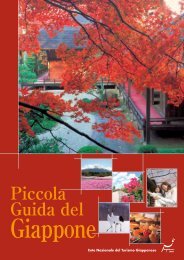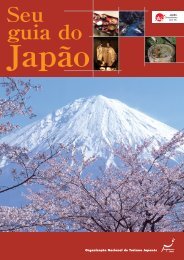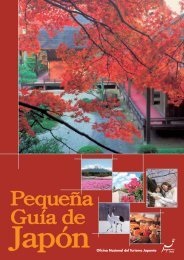Your Guide to - Japan National Tourist Organization
Your Guide to - Japan National Tourist Organization
Your Guide to - Japan National Tourist Organization
You also want an ePaper? Increase the reach of your titles
YUMPU automatically turns print PDFs into web optimized ePapers that Google loves.
This one is a wooden<br />
structure built some<br />
1,400 years ago. And the other<br />
is a ferroconcrete structure<br />
built only one year ago.<br />
Both are great architectural<br />
works that embody<br />
the pride of <strong>Japan</strong>.<br />
Where is the world's oldest wooden structure and where is the<br />
largest one? Yes, they are both in <strong>Japan</strong>. The former is Horyuji<br />
Temple (built in 607) and the latter is Todaiji Temple (the existing one,<br />
reconstructed in 1709, is 57 meters high). Buddhist structures in <strong>Japan</strong><br />
have developed and retained purely <strong>Japan</strong>ese architectural features,<br />
though they had long been under the strong influence of China. You will<br />
find a number of superb traditional structures around <strong>Japan</strong>, including<br />
those in the ancient capitals of Nara, Kyo<strong>to</strong> and Kamakura.<br />
From the latter half of the 16th century through the 17th century,<br />
feudal lords in <strong>Japan</strong> vied with each other <strong>to</strong> build their own magnificent<br />
castles as a demonstration of power. The most famous among them is<br />
the graceful Himeji Castle. However, traditional structures are not the<br />
only buildings that represent <strong>Japan</strong>ese architectural mastery. Modern<br />
western architecture has had great influence on <strong>Japan</strong> since the<br />
latter half of the 19th century. It should be noted that since times<br />
of old the <strong>Japan</strong>ese have regarded structures as beautiful only<br />
when they harmonize with their surrounding natural<br />
environments.<br />
Architecture<br />
Today's expressive designs and materials may differ from<br />
those used in the past, yet the tradition stressing<br />
harmony with nature has continued and is embodied in<br />
many of the masterpieces by contemporary <strong>Japan</strong>ese<br />
architects. Contemporary <strong>Japan</strong>ese architecture<br />
is said <strong>to</strong> be full of originality and can be so<br />
exciting that you may call it a "product of<br />
ongoing experiments." Compare the old and the<br />
new in architectural <strong>Japan</strong>. You are in for great<br />
surprises and a lasting impression.<br />
Alluring Charms of <strong>Japan</strong><br />
Awaji Yumebutai:<br />
Under the theme "Creation of the lost forest<br />
of our home," Awaji Yumebutai has been<br />
designed by Tadao Ando, a celebrated<br />
contemporary <strong>Japan</strong>ese architect.<br />
Naoshima<br />
Contemporary<br />
Art Museum:<br />
This museum of modern art<br />
stands on a hill on<br />
Naoshima Island. Also<br />
designed by Tadao Ando.<br />
Nicknamed the "Castle of<br />
the White Heron", it is<br />
designated a <strong>National</strong><br />
Treasure and registered as a<br />
World Cultural Heritage site.<br />
Tokyo Metropolitan Government:<br />
This twin-<strong>to</strong>wer building soars high above<br />
the Shinjuku district of Tokyo. Designed by<br />
Kenzo Tange.<br />
Himeji Castle:<br />
Horyuji Temple:<br />
The oldest existing<br />
Buddhist temple in<br />
<strong>Japan</strong> and the<br />
world's oldest<br />
wooden structure.<br />
Registered as a<br />
World Cultural<br />
Heritage site.

















